
Brooketon Colliery, formerly known as Muara Coal Mine, was one of the underground coal mines in Brunei.

Brooketon Colliery, formerly known as Muara Coal Mine, was one of the underground coal mines in Brunei.
The Brooketon Colliery is located in Serasa. It is located to the north of the roundabout where Jalan Muara meets the Muara–Tutong Highway about one and a half miles away from Muara Town centre.
Coal was first reported in Brunei Darussalam near Muara as early as 1837. [1] in Serai Pimping. The Muara coalmine was first mined commercially in 1883, when William Cowie was given the concession rights to mine the coal in exchange for $1,200 per year. [2] However, Cowie later sold his rights to Rajah Charles Brooke and the Rajah renamed the mine Brooketon (Brooke Town). Between 1889 and 1924, it was operated by the Sarawak government of Rajah Charles Brooke. Annual exports of coal varied between 10,000 and 25,000 tons annually and in those 33 years of operation, more than 650,000 tons were exported. [1] At first it was opencast until it became harder and underground mining was introduced.
Brooketon Colliery was strategic as it was very near to Muara where then and now there is a safe deep-water anchorage to which the mine was connected via rail. [2] During the time the mine was in operation, there was a wooden rail line that connected Brooketon which is about one and a half mile away from Muara. The rail line is no longer in place.
Politically too, even though he only had economic rights, Brooke became the de facto ruler of the area. The mine employed hundreds of miners and that required him to introduce a police force, post office and roads transforming Muara into an extraterritorial settlement an extension of Sarawak. It was not until 1921 that Muara was "returned" to Brunei.
It closed down in 1924 because of heavy financial losses caused by continuously decreasing coal prices in the world economic recession. [1]
All that remains of the mine today is an overgrown railway, locomotives, mine entrances and an abandoned Morris Minor. [3]
The Museums Department of Brunei wanted to turn the historical 62 hectares coal mine as an open site museum to promote the country's eco-tourism. [2] It is currently already a protected site under the Antiquities and Treasure Trove Act of Brunei Darussalam. [2]

Brunei, formally Brunei Darussalam, is a country in Southeast Asia, situated on the northern coast of the island of Borneo. Apart from its coastline on the South China Sea, it is completely surrounded by the Malaysian state of Sarawak, with its territory bifurcated by the Sarawak district of Limbang. Brunei is the only sovereign state entirely on Borneo; the remainder of the island is divided between Malaysia and Indonesia. As of 2020 the country had a population of 460,345, of whom approximately 100,000 resided in the capital and largest city Bandar Seri Begawan. The government of Brunei is an absolute monarchy ruled by the Sultan of Brunei, and it implements a fusion of English common law and jurisprudence inspired by Islam, including sharia.
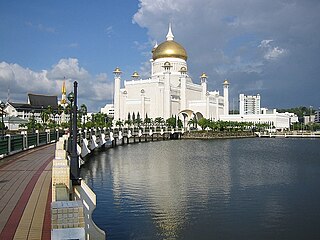
Brunei-Muara District or simply Brunei-Muara is one of the four districts of Brunei. It has the smallest area among the four districts, with 571 square kilometres (220 sq mi), yet is the most populous, with 289,630 people as of 2016. Bandar Seri Begawan, the country's capital, is located in this district, which is also de facto the district's capital. It is also home to Brunei International Airport, the country's only international airport, as well as Muara Port, the main and only deep-water port in the country. The Brunei River flows within this district and is home to Kampong Ayer, the traditional historic settlement on stilts above the river.

Limbang is a border town and the capital of Limbang District in the Limbang Division of northern Sarawak, East Malaysia, on the island of Borneo. This district area is 3,978.10 square kilometres, and population was 56,900. It is located on the banks of the Limbang River, between the two halves of Brunei.

Omar Ali Saifuddin II was the 23rd Sultan of Brunei. During his reign, Western powers such as the United Kingdom and the United States visited the country. His reign saw the British adventurer James Brooke becoming the White Rajah of Sarawak.

The White Rajahs were a dynastic monarchy of the British Brooke family, who founded and ruled the Raj of Sarawak, located on the north west coast of the island of Borneo, from 1841 to 1946. The first ruler was Briton James Brooke. As a reward for helping the Sultanate of Brunei fight piracy and insurgency among the indigenous peoples, he was granted the province of Kuching, which was known as Sarawak Asal in 1841 and received independent kingdom status.
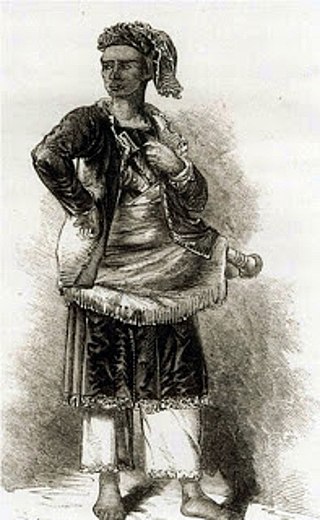
Abdul Momin was the 24th Sultan of Brunei from 1852 until his death in 1885.

Muara Town or simply Muara is a port town in Brunei-Muara District, Brunei, about 28 kilometres (17 mi) from the capital Bandar Seri Begawan. The population of the town proper was 2,102 in 2016. It is home to Muara Port, the country's primary deep water port.

The Raj of Sarawak, also Kingdom of Sarawak or State of Sarawak, located in the northwestern part of the island of Borneo, was an independent state with a treaty of protection with United Kingdom starting from 1888. It was established as an independent state from a series of land concessions acquired by an Englishman, James Brooke, from the Sultan of Brunei. Sarawak was recognised as an independent Sovereign state by the United States in 1850 and by the United Kingdom in 1864. The Kingdom is now the Malaysian state of Sarawak.
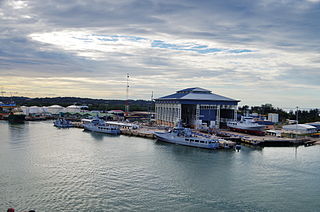
Mukim Serasa is a mukim in Brunei-Muara District, Brunei. The population was 16,173 in 2016. The mukim encompasses Muara Town, home to Muara Port, the country's only deepwater port.
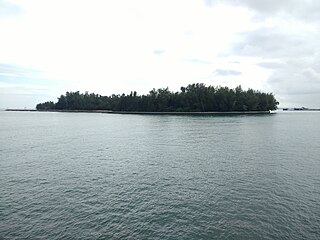
Pelumpong Spit is the easternmost point in the Brunei-Muara district of Brunei. Despite its name being labeled as a spit, it is now an island due to the artificially constructed 50m-wide, 10m-deep Muara cut, which separated the spit from the mainland to provide access to Muara Port.

The Brunei–Malaysia border divides the territory of Brunei and Malaysia on the island of Borneo. It consists of a 266 km (165 mi) land border and substantial lengths of maritime borders stretching from the coastline of the two countries to the edge of the continental shelf in the South China Sea.
The Eastern Archipelago Company was a company incorporated by British royal charter in 1847. It was active on the island of Labuan off the coast of Borneo from its creation until its dissolution in 1858.
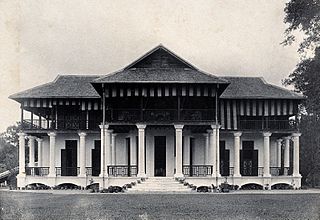
Borneo Company Limited, formed in 1856, was one of the oldest companies based in East Malaysia.

Haig Colliery was a coal mine in Whitehaven, Cumbria, in north-west England. The mine was in operation for almost 70 years and produced anthracitic coal which is most useful for coking coal. Situated on the coast, the underground workings of the mine spread westwards out under the Irish Sea and mining was undertaken at over 4 miles (6.4 km) out underneath the sea bed.

William Clark Cowie was a Scottish engineer, mariner, and businessman who helped establish British North Borneo and was Chairman of the British North Borneo Company.

Transport in Brunei consists of air, land, and sea transport. Previously there was some rail transport in Brunei, but eventually most of it was closed down. Several public and commercial sector organizations are in charge of creating and overseeing these networks and infrastructures. The Ministry of Transport and Infocommunications (MTIC) is in charge of overseeing the maritime and aviation industries, as well as planning and regulating all kinds of land transportation.

Rail transport in Brunei did not play an important role during the development of Brunei.

Tahmoor Colliery is an underground coal mine at Tahmoor in the Southern Highlands region of New South Wales, Australia. It operates in the Bulli coal seam. Most of the mine product is hard coking coal used for steel making. A small quantity of steaming blend coal used for power generation is also produced. Both products are exported to Europe and Asia.

Berambang Island is an island at the southern bank of the Brunei River in the Mukim Kota Batu, Brunei-Muara District, Brunei. The island was formerly named Buang Tawer during The Brooke Era from 1841 until 1941. The mausoleum of the 9th Sultan of Brunei, Sultan Muhammad Hassan is located on the island, near Kampong Sungai Bunga.